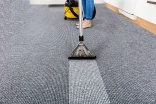Home › magazine › special features › Carpet care on every level
Carpet care on every level
13th of October 2025Vacuuming, stain removal, deep cleaning, bonnet cleaning: carpet care operates on a number of different levels. Ann Laffeaty asks manufacturers to explain what they are and finds out how customers can choose the right level of clean.
CARPET CLEANING CAN MEAN one of several different things. It can involve a quick once-over with a dustpan and brush, for example, or a few fast passes with a vacuum to pick up the loose dirt. It can
refer to an intensive spot-clean to deal with a specific spill. And a deep clean might be required to restore the carpet to a pristine condition.
But how does a customer choose between these different levels of carpet cleaning? It all depends on the type of clean they are seeking to achieve, says Industrial Cleaning Equipment’s chief marketing and communications officer Julie Kitchener.
“For example, a light vacuum might be carried out daily in a low maintenance area whereas extraction cleaning would be required less frequently, depending on the environment,” she said. “And a deep clean will only take place once or twice a year since it involves a thorough clean of everything.”
A light vacuum is often the most appropriate solution in a home or office, she says, while spot cleaning might be required to remove a localised stain from a carpet that is otherwise mostly clean. “Regular spot cleaning helps to maintain the overall appearance of a carpet between deep cleaning sessions,” says Kitchener. “It extends the life of the carpet and preserves its aesthetic appeal. And quick action is crucial for effective spot cleaning because the sooner a spill is addressed, the higher the chances of its complete removal.”
Extend lifespan
Deep cleaning removes dirt, stains and odours that have become embedded within the carpet fibres. “In this way it extends the carpet’s lifespan and improves hygiene levels,” adds Kitchener. “Deep cleaning also has the benefit of removing dust mites, pet dander and other substances that can trigger allergy symptoms. It also improves indoor air quality since it removes any pollutants trapped in the carpet fibres. And it promotes a healthier environment because it helps to eliminate the bacteria and mould spores that can accumulate.”
Regular deep cleaning helps to prevent the build-up of dirt and debris that could cause the carpet fibres to wear down over time, said Kitchener. “It removes stubborn stains and eliminates odours, and a carpet that has been deep cleaned has a fresher, more inviting appearance that will enhance the overall aesthetic of your facility.”
Dry cleaning is one of the most modern cleaning technologies around today, she adds. “This involves applying a cleaning compound or powder and working it into the fibres with a motorised rotating brush machine. “That produces an effective result and requires little drying time.”
Synthetic detergents
Foam cleaning - or encapsulation - is another option, she explains. “This process uses synthetic detergents as a base that crystallise into powder as they dry,” she said. “When applied to the carpet, the cleaning agent loosens the dirt and encapsulates it into the powder. And once dry the solution may be vacuumed or brushed away.”
Other methods include bonnet cleaning and steam cleaning. “Bonnet cleaning provides good surface results because the process primarily involves cleaning the top layer of the carpet fibres,” she said. “This is mostly used for routine light maintenance and involves the use of a rotary floor machine plus a pad soaked in a cleaning solution to remove the dirt.
“And steam cleaning – also known as hot water extraction or wet cleaning - uses water at high pressure to disturb the carpet fibres and dissolve the dirt. This technique involves the use of pressurised water and a vacuum to remove dirt and debris stuck inside the carpet fibres.”
Industrial Cleaning Equipment offers a range of carpet cleaning equipment including upright and tub vacuums, cobotic machines for use in larger areas and a lightweight extraction machine said to be ideal for use in pubs, clubs, hotels, offices and care homes. The company also offers powerful industrial carpet cleaners for use in high-traffic areas plus the ICE C-Care Lite, described as an entry-level professional carpet and upholstery spray extractor.
Kärcher’s cleaning solutions consultant Gundula Braun considers there to be four levels of carpet cleaning. “The first is to take preventative action to protect the carpet by sweeping outdoor areas and by providing an effective entrance matting system,” she said. “The second is a daily vacuum and spotting routine depending on the level of footfall.
“The third level - interim carpet cleaning - should be employed when these daily routines no longer maintain the carpet’s appearance to the desired level. This requires the use of compact, easy-to-use equipment combined with small amounts of water and a cleaning agent to provide optimum results in the fastest possible time. And deep cleaning is the fourth level where there is a need to remove stubborn, adhesive dirt from the fibres down to the carpet backing to restore it as closely as possible to its original condition. Here the appropriate drying time, aided by the use of air blowers, forms an important part of the process.”
A light vacuum is appropriate whenever there is a need to remove visible, loose dirt quickly and quietly, she said. “In areas with heavy foot traffic, vacuuming needs to be carried out multiple times per day to promptly remove visible dirt and maintain the appearance of the carpet,” she said. “But in other, less frequently-used areas a single daily light vacuuming procedure might be sufficient.”
Spot cleaning forms an integral part of the daily maintenance of carpets, says Braun. “Time is of the essence when it comes to stain removal. Stains are treated with water or a suitable cleaning agent depending on their nature. Immediate spot cleaning will prevent the stain from permeating more deeply into the pile. It also stops the stain from setting and becoming a source of malodour.”
Interim cleaning
She says interim cleaning is required when the carpet begins to look worn despite the daily cleaning procedures. “This is designed to delay the need for a time-consuming deep clean,” she said. “It is particularly suitable for moisture-sensitive floor coverings or for areas that need to be quickly accessible again such as hotel corridors and guest rooms.”
Interim cleaning uses an encapsulation agent to loosen and bind the dirt which is then vacuumed away. “This process is more thorough than daily vacuuming, but does not reach too deeply into the pile nor into the carpet backing,” said Braun.
Kärcher’s carpet cleaning solutions include the EB 30 battery-powered carpet sweeper for use in smaller high-traffic areas such as lobbies, lifts and break-out areas. The company also offers the Puzzi range of spray extraction machines for deep fibre carpet cleaning, and the BRC 30/15 C which is a pull-back motion carpet cleaning machine designed for restorative cleaning routines in medium-sized areas.
Regular vacuuming is the first principle of carpet cleaning, says Prochem’s director of sales and training Phil Jones. “The act of removing dry soiling from the carpet’s surface will prevent debris such as grit, dust and skin cells from permeating the fibres, building up and potentially becoming an abrasive material that reduces the lifespan of the carpet,” he said. “A cylinder or tub vacuum should be used regularly but this should be dovetailed with an upright vacuum cleaner which provides a deeper dust extraction method.”
He describes spot cleaning as the most important part of the process. “End-users often think they need a carpet clean when they actually only require spot-removal,” he said. “However, a spill or stain may take several attempts to remove, and professional cleaning contractors will understand this. It all depends on the value of the carpet’s visual impact to the customer.”
The appearance of the carpet is particularly important in a hotel environment, he says. “Here the housekeeping manager needs to understand that a professional contractor might take time to successfully complete the task,” he said. “However in an office environment, the reduction of the stain may be the best possible result.”
Prochem manufactures carpet cleaning detergents and machinery as well as operating training courses. These cover the principles of cleaning with rotary machines, rinse-extraction machinery and CRB machines as well as bonneting and skimming.
Dry soil and sticky dirt are the two main types of carpet soiling, according to Jones. “Dry soil and dust will lie on top of the carpet and will drop deeper into the pile over time,” he said. “This is where the professional vacuum cleaner comes into play. An upright, twin-motored brush roller machine will flick or brush the soil up from the bottom of the carpet into the airflow and into the vacuum bag.”
Dry compounds
Greasy, sticky dirt is often walked into a carpet via the shoes, he adds. “This will naturally dull down the carpet’s visual impact and it will then need cleaning,” he said. “The task here will require the use of moisture and detergent to release the soil’s magnetic attraction to the fibre. This is called saponification - the process of turning greasy soils into a water-rinseable soap.”
Low-moisture methods of cleaning include bonneting, encapsulation and the use of dry compounds, says Jones. “These systems allow the contractor to clean an area of anything from between 250 and 350 square metres per hour.”
Many commercial cleaning contracts are sold in on the basis that a deep clean will be carried out two or three times a year, he explained. “However if the client allows for a regular maintenance clean to run alongside the deep-cleaning schedule, the contractor is often able to offer a far better service.”
A deep clean is often the solution the customer expects, he adds. “Most cleaning companies also think a deep clean is the only way to clean a carpet. “And this process not only removes the greasy soils but also helps to remove or reduce the allergens and bacteria, improving the air quality of the environment.
“But when you consider the productivity involved in the process, it can make any commercial job very costly. So the many other different levels of carpet cleaning that exist can increase productivity and reduce costs for the cleaning company.”











